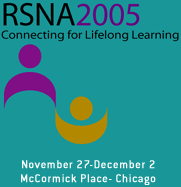
Abstract Archives of the RSNA, 2005
Johannes Wessling MD, Presenter: Nothing to Disclose
Roman M. Fischbach MD, Abstract Co-Author: Nothing to Disclose
Rainer Esseling MS, Abstract Co-Author: Nothing to Disclose
Rainer Raupach PhD, Abstract Co-Author: Nothing to Disclose
Walter Leonhard Heindel MD, Abstract Co-Author: Nothing to Disclose
To assess the effect of dose reduction and the potential of noise reduction filters on image quality and detection of lesions on liver CT images.
18 patients (age range, 44-81 years) with known or suspected liver lesions were scanned with a 16 multi-detector row CT (Somatom Sensation 16, Siemens: slice thickness 1 mm, reconstruction interval 0.8 mm, 120 kV ,180 mAs). Virtual noise was added to the baseline liver CT raw datasets (portal venous phase) simulating effective mAs levels of 155, 130, 105, 80, 55, 30 and 10 mAs (Syngo Explorer, Siemens). In addition, all datasets were postprocessed with an edge preserving noise reduction filter (ANR-3D), thus resulting in a total of 15 datasets per patient. Ten blinded radiologists performed independent evaluation of randomized images for diagnostic acceptability, presence, number and conspicuity of liver lesions. Quantitative noise and contrast-to-noise ratio were obtained for all liver lesions. Statistical analysis was performed by using the Wilcoxon test signed rank test.
Significant reduction of image noise was observed in images processed with the “ANR-3D” filter (p< .05). A total of 25 lesions (diameter 3 to 48 mm, including 9 cysts, 9 metastases, 3 hemangiomas, 4 carcinomas) were present in 10 patients. Sensitivity for lesion detection, as compared to the baseline 180 mAs dataset remained high for datasets down to 105 mAs without filter and 80 mAs with ANR-3D (Sensitivity without/with ora3D: 80mAs; 96%/100%, 55mAs; 80%/96%, 30mAs; 60/80%, 10mAs; 40%/52%, p<.05). Lesion conspicuity was rated significantly higher for datasets reconstructed with ANR-3D but decreased with dose reduction.
The use of a novel noise reducing but edge preserving filter (ANR-3D) provides an option for further reduction of radiation dose in liver CT.
R.R.: Dr. Rainer Raupach works for Siemens Medical Solutions
Wessling, J,
Fischbach, R,
Esseling, R,
Raupach, R,
Heindel, W,
Effect of Dose Reduction and Noise Reduction Filters on Detection of Liver Lesions Using Multi-detector Row CT. Radiological Society of North America 2005 Scientific Assembly and Annual Meeting, November 27 - December 2, 2005 ,Chicago IL.
http://archive.rsna.org/2005/4416309.html

